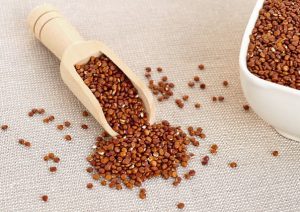Top Five Gluten-Free Grains
Here are the top Five Gluten-Free Grains which should be present in our diet. One can get insights about the five best grains to include in our food and why they should include in their breakfast. They are
- Quinoa
- Brown Rice
- Millets
- Buckwheat
- Amaranth
What are these Grains ?
Quinoa: It is one of the top five gluten-free grains which is a highly nutritious grain that is rich in protein, fiber, and various essential minerals. It’s also a good source of antioxidants and may help improve blood sugar control.
1. Brown Rice: One can get a good quantity of fiber vitamins and minerals from this whole grain. It acts as an antioxidant and may help lower cholesterol levels.
2. Millet: Millet is a gluten-free grain that is rich in nutrients like magnesium, phosphorus, and antioxidants. It may also help improve heart health and lower blood sugar levels.
There are different types of millet. The common kinds of millet available widely are
Types of Millets
a) Pearl Millet: Also known as bajra, pearl millet is the most widely cultivated type of millet. It has a slightly nutty flavor and can be used to make khichdi, soup, poha, flatbread, and many more.
b) Finger Millet: Also known as ragi, it is a little sour in taste and is a staple crop in several regions of Africa and Asia. It is one of the most common millet available. Ragi is also the best food option for toddlers and babies above 6 months. It is easily digestible and is good for people suffering from Irritable Bowel Syndrome (IBS).
c) Foxtail Millet: Foxtail millet is a small, yellow grain that has a mild, nutty flavor. It’s often used to make porridges, upmas, and dosas.
d) Proso Millet: It is a small, round grain that has a mild, nutty flavor. It’s often used in birdseed mixes but can also be used to make porridges and pilafs.
e) Little Millet: Little millet is a small, round grain that has a mild, nutty flavor.
- Buckwheat: Buckwheat is a highly nutritious gluten-free grain that is rich in protein, fiber, and essential minerals like magnesium and zinc. It may also help lower blood pressure and improve heart health.
- Amaranth: Amaranth is a gluten-free grain that is high in protein, fiber, and essential minerals like iron and calcium. It may also help improve cholesterol levels and reduce inflammation in the body. Amaranth flour can also be used as a gluten-free alternative to wheat flour.
Nutritional Benefit of Gluten-Free Grains
Quinoa
- Carbohydrates: A good source of complex carbohydrates, which provide long-lasting energy. The low glycemic index does not increase your blood sugar Protein: Quinoa is one of the few plant-based foods that is a complete protein, meaning it contains all nine essential amino acids. It is the best protein-rich grain for vegans.
- Fiber: Quinoa is high in fiber, which is essential for digestive health and may also help reduce the risk of chronic diseases such as heart disease and type 2 diabetes.
- Fat: Quinoa is low in fat and contains mostly healthy unsaturated fats. It also contains a small amount of omega-3 fatty acids, which are important for brain health.
- Vitamins and minerals: It has magnesium, phosphorus, potassium, and folate. It also contains small amounts of iron and zinc.
Brown Rice
- Carbohydrates: Brown rice is a good source of complex carbohydrates, which provide long-lasting energy. It has a lower glycemic index compared to white rice and so it doesn’t increase your sugar levels.
- Fiber: Brown rice is high in fiber, which is important for digestive health and can also help reduce the risk of chronic diseases such as heart disease and type 2 diabetes.
- Protein: Brown rice contains some protein, although it is not a complete protein like quinoa. It can be combined with other plant-based protein sources, such as beans or tofu, to make a complete protein.
- Vitamins: Brown rice is a good source of several vitamins, including thiamin (vitamin B1), niacin (vitamin B3), and vitamin B6. Thiamin is important for maintaining healthy nerve and muscle function, while niacin and vitamin B6 are important for energy metabolism.
- Minerals: Brown rice is a good source of several minerals, including magnesium, phosphorus, and selenium. Magnesium is important for bone health, while phosphorus is important for healthy teeth and bones. Selenium is a powerful antioxidant that may help reduce the risk of certain cancers.
Millet Nutrition
- Carbohydrates: Millet is a good source of complex carbohydrates, which provide sustained energy and can help regulate blood sugar levels.
- Fiber: Millet is high in fiber, which is important for digestive health and can also help lower cholesterol levels and reduce the risk of heart disease.
- Protein: Millet is a good source of plant-based protein, containing about 6 grams of protein per cooked cup. It’s not a complete protein, but can be combined with other protein sources to make a complete protein.
- Vitamins: Millet is a good source of several vitamins, including thiamin (vitamin B1), riboflavin (vitamin B2), and niacin (vitamin B3). These vitamins are important for energy metabolism and maintaining healthy skin, eyes, and nervous systems.
- Minerals: It has a good amount of magnesium, phosphorus, and potassium. Magnesium is important for bone health, while phosphorus is important for healthy teeth and bones. Potassium helps regulate blood pressure and heart function antioxidant:
- Anti Oxidants- It contains several antioxidants, including phenolic acids and flavonoids. These compounds help protect the body against damage from harmful molecules called free radicals, which can contribute to chronic diseases.
Millets like ragi or Finger Millet are also great food for recovery from cancer and can be consumed while going through the recovery phase.
Amaranth
Amaranth is a gluten-free pseudo-cereal that is rich in nutrients and provides several health benefits.
- Carbohydrates: Amaranth is a good source of complex carbohydrates
- Protein: Amaranth is a high-quality source of plant-based protein, containing about 9 grams of protein per cooked cup. It is also a complete protein, which means it contains all nine essential amino acids that the body needs.
- Fiber: Amaranth is high in fiber, which is important for digestive health and can also help lower cholesterol levels and reduce the risk of heart disease.
- Vitamins: Amaranth has a good quantity of vitamins, including folate (vitamin B9), vitamin C, and vitamin K. Folate is important for healthy fetal development, while vitamin C is an antioxidant that helps protect the body against disease. Vitamin K is needed for blood clotting and bones.
- Minerals: It has calcium, iron, and magnesium. Calcium is important for strong bones and teeth, while iron is important for healthy red blood cells. Magnesium is important for nerve and muscle function, as well as bone health.
- Antioxidants: Amaranth contains several antioxidants, including phenolic acids and flavonoids. These compounds help protect the body against damage from harmful molecules called free radicals, which can contribute to chronic diseases.
Buckwheat Advantage
Buckwheat is a highly nutritious seed that offers several health advantages.
- Rich in Nutrients: Buckwheat is a good source of nutrients such as protein, fiber, vitamins, minerals, and antioxidants. It contains significant amounts of manganese, magnesium, copper, and phosphorus.
- Gluten-free: Buckwheat is a naturally gluten-free seed, which makes it a great option for people with celiac disease or gluten sensitivity.
- May Improve Heart Health: Buckwheat has been shown to help lower cholesterol levels and improve blood pressure, which can reduce the risk of heart disease.
- May Improve Blood Sugar Control: Buckwheat is low on the glycemic index, which means it doesn’t cause a rapid spike in blood sugar levels. It helps in managing insulin sensitivity in diabetic patients.
- May Aid Digestion: Buckwheat is rich in fiber, which can help promote healthy digestion and prevent constipation.
- Versatile Ingredient: Buckwheat can be used in a variety of dishes, including pancakes, noodles, bread, and porridge.
Overall, these super grains should be added to your food to provide a range of health benefits and add variety to your meals. They are easily available online as well as in stores and make great food options. All these power-packed grains can be used as a healthy alternative for wheat lovers.




